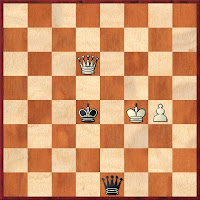Rook and Knight pawns usually draw if:
- the defending king reaches the promotion corner.
- the defending king reaches the corner opposite the promotion corner.
 |
- the defending king gets in front of or very near the pawn
 |
The stronger side should prevent the defending king from reaching a drawing zone, move their king to the same rank or file as the attacking king to threaten a queen exchange, centralize their queen, and advance their pawn.
 |
In the above diagram, both kings are on the same rank, so Black must be careful to avoid queen exchanges. 1...Kc3?? 2.Qe5+! Qxe5+ 3.Kxe5 +-
And that's what you need to know in a nutshell. :)
Further Resources:
- Fundamental Chess Endings, pgs 316-321
- Queen and Rook's Pawn vs Queen I
- Queen and Rook's Pawn vs Queen II

11 comments:
Hello likesforest,
Nice post!
I have severe headaches when it comes to Q+P v Q endgames. Because unless you happen to have a tablebase handy, it's very hard to do this OTB and with pressurising time controls.
The only thing I know for Q+P v Q endgames is always be careful of counter-checks. :)
My general principle is for the side with the pawn, centralise the Queen and try to stop your opponent's king from reaching the drawing zone if possible.
I was once forced to draw with my opponent in an OTB game in a QvR endgame. There just wasn't enough time to break the 3rd rank defence, then 2nd rank defence and getting to Philidor's position within 50 moves. I still have regrets about that game. :(
I'm going to ask a really stupid question. Since I posted my ending article I keep hearing about tablebases. What are they? I have Chessbase 9, but I know I don't use it very efficiently so what am I missing?
tablebases or rather endgame tablebases are endgame positions that the computers have run through and can predict the most optimal path to a draw or a win.
For more info. See the following link: :)
http://en.wikipedia.org/wiki/Endgame_tablebase
cheers.
An endgame tablebase is a databass that tells you what's the result of any endgame position. Unlike a chess engine, it's 100% accurate and you instantly know the result.
Many tournament players have the 3/4/5 man Nalimov tablebase. That tells you the result of positions with five or fewer pieces on the board--for example K+R+P vs K+R. It takes about 8GB of disk space and you can download it for free.
Once you've downloaded a tablebase, in Chessbase go to Tools | Options | Tablebases and tell it where to find it and Chessbase will become much faster at evaluating endgames with 5-7 pieces on-board.
6-man tablebases are also available but they take a whopping 1 TB. For the occasional lookup you can use this website:
http://www.shredderchess.com/online-chess/online-databases/endgame-database.html
7-man tablebases should be released in 2015 and will be HUGE.
Happy, yeah, Q+P vs Q is a tactical minefield but the drawing zones at least make some sense of it. Fine's Basic Chess Endings only says that rook & knight pawns are drawish and central & bishop pawns usually win. But he didn't have the advantage we have nowadays of tablebases and Mueller's wonderful explanations based on analyzing those.
"I was once forced to draw with my opponent in an OTB game in a QvR endgame."
Ouch! I'm not sure I would do better. Q vs R is very tricky when your opponent knows how to defend properly. Like you said, there's the 3rd rank defense, then the 2nd, then Philidor...
Oops, here's the 6-man link.
i doubt our computers have the hard disk space for 7 man tablebases. :)
the defending king reaches the corner opposite the promotion corner
What is the drawing trick after this?
the defending king reaches the corner opposite the promotion corner
"What is the drawing trick after this?"
Just keep checking the attacking king so he doesn't have time to advance his pawn, or pin the pawn to the attacking king.
The defending king wants to be far from the action (the drawing zone) so he can avoid a queen exchange.
If the defending king is too close, the attacker can often meet a check with a counter-check (a king-queen fork), which forces a queen trade. Then the stronger side wins easily.
The last diagram is an example of a king-queen fork forcing a queen exchange.
Likeforests: Is that you with a score over 600,000 at Troyis?
Post a Comment